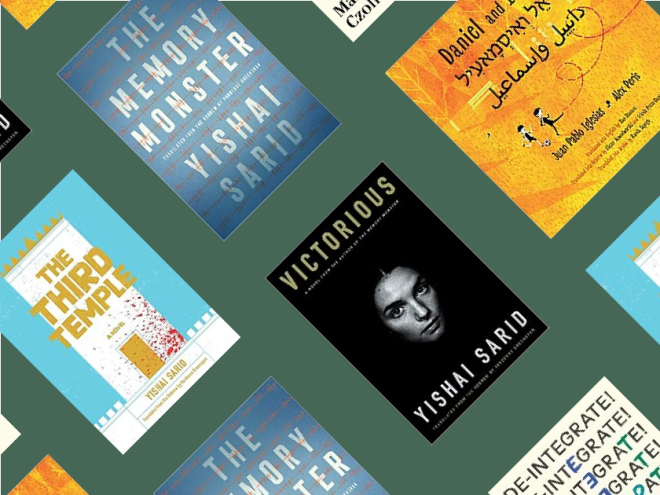This major collection of Ilan Stavans’s shorter writings confirms his place as a premier interpreter of the Jewish experience in the Americas. Primarily concerned with the narrative arts (literature and film), his range is wide and his penetration is deep. As he battles through the distinctions between the intellectual and the academic, the creative spirit and the critical one, Stavans is at once erudite, relaxed, and friendly. Often seriously engaged with highbrow achievement, he is not condescending to writers of lower elevation – such as Leo Rosten.
Stavans employs his considerable intelligence and knowledge in a particularly therapeutic way. For one thing, he reminds us not to confuse Spanish-speaking Jews with Sephardim. Born into an Ashkenazi Mexican family, he represents a stratum of Latino culture underrepresented on most North American maps of Jewish life and achievement. Yet Stavans has made New York and Boston his homes for half of his life. Intellectually and emotionally, he is at home with the giants (and the overlooked) of modern Western culture in both its Spanish and English streams. And let’s not forget about Yiddish!
In this dazzling sampler of his work, we encounter short essays (book reviews, brief critical meditations, tributes) and longer sojourns into multi-layered topics: “Thinking Aloud: The Education of Maurice Samuel,” “Rereading Lionel Trilling,” “Sephardic Literature: Unity and Dispersion,” and – of course – the magnificent title essay “Singer’s Typewriter and Mine.” In many of these pieces, Stavans knits the circumstances of his own life into the exploration of his ostensible subject. Somehow, he manages to make this kind of risk-taking productive rather than intrusive.
Stavans is in love with the mysteries of languages, and he has the equipment to examine their operations and their occasional interpenetrations. Ladino and Spanglish are among his interests, and translation is for him a term with so many connotations that he employs the word metaphorically.
The section of this book titled “Conversations” has a special charm and power. Stavans’s engagement with his counterpart is not the conventional interview, but a more even-handed exchange. Pieces like “The Buenos Aires Affair, with Nathan Englander” and “Nostalgia and Recognition, with Morris Dickson” bring us two minds rocking back and forth, each finding a new twist or turn of apprehension in the duet, perhaps undiscoverable in solo mode.
Children’s picture books, graphic novels, films like “Nora’s Will,” and the graces of marginality are all parts of the eclectic carousel of determined exploration that distinguishes the genius of Ilan Stavans. Author bibliography, source acknowledgments.
Read Ilan Stavans’s Posts for the Visiting Scribe
Fate Knocking at the Door: An Interview with Ilan Stavans
Philip K. Jason: What binds your interest in comic strips and graphic novels on the one hand and more traditional critical explorations on the other?
Ilan Stavans: Storytelling is a form of midrash. I love telling stories, analyzing them, seeing them in context. I grew up in a culture that juxtaposed the word and the image. As a writer, I don’t see one as superior to the other. I also don’t see the distinction between highbrow and popular readerships. The capacity to enthrall knows no boundary.
PKJ: Prof. Stavans, as a character in your graphic novel El Iluminado (Basic Books, 2012), is directly involved in a real world adventure. What do you say to those who feel that people in academic life somehow have removed themselves from real world experiences?
IS: For me the noun academic is derogatory: it denotes affectation, posturing, pretense. Academic life is shamefully aloof, removed from the nuts-and-bolts affairs of daily Americans. I feel uncomfortable with such elitism: I prefer to get my hands dirty, to delve into the frying pan.
PKJ: Tell me something about the background of the family name.
IS: In vain I’ve sought my roots in nineteenth-century Europe. My consolation is the knowledge that my ancestors have roots in the Pale of Settlements, although I don’t know how deep those roots are. My full name (oy gevalt!) is Ilan Kalmen Stavchansky Slomianski Altchuler Eisenberg. Stavchansky probably refers to Stavchany, in the Ukraine. My father, Abraham Stavans, a stage and soap-opera actor in Mexico, shortened the name for artistic reasons, although he never made the move to change it officially. I chose Ilan Stavans to emphasize my debt to him. I discuss this debt in my memoir On Borrowed Words (Penguin, 2002).
PKJ: One of your concerns in Singer’s Typewriter and Mine: Reflections on Jewish Culture (Nebraska, 2012) is about the future of ethnic identities in “melting pot nations” versus “fruit salad” nations. You discuss this in your new book The United States of Mestizo (NewSouth, 2013), which is based on an article you published in Humanities. Can public policy or private advocacy lead to one or another outcome in heterogeneous societies?
IS: The United States is a gorgeous mosaic of ethnicities. Regardless of policy, the nation’s future is Babel-like: a sum of parts. I’m an American because I chose to immigrate to it in 1985. That is, I chose to become a convert to the religion we call “America,” to become a practitioner, to support, for better or worse, its principles.
PKJ: Am I safe to assume that, in your opinion, translation is a term with multiple meanings, going beyond the attempt to render a text composed in one language into another? You’ve translated Pablo Neruda, Borges, and Juan Rulfo from the Spanish into English, Singer from Yiddish to Spanish, Yehuda ha-Levi and Yehuda Amichai from Hebrew to English, Shakespeare, Emily Dickinson, and Elizabeth Bishop from English to Spanish. You’ve also written frequently on the role of translation in the shaping of nations.
IS: For me translation is a way of life. In fact, I live in translation without an original.
PKJ: What do you mean?
IS: In traveling from one language to another, I no longer know if there is a right way of saying things or many right ways.
PKJ: One of your life-long interests is Spanglish. You’ve published a dictionary (Harper, 2003) as well as a translation of Don Quixote of La Mancha into Spanglish. Does Spanglish have its correlatives in other language blends? In Yiddish or Hebrew blends? How and for whom do these hybrids function?
IS: Spanglish is the new Yiddish: a mix of Spanish and English used by Latinos to communicate across national, ethnic, and economic lines. Like Yiddish, it was looked down upon by the educated elite as bastardization. Then writers embraced it as theirs, producing novels, theater, music, poetry, hence giving it an incipient standardized syntax. It is spoken by millions not only in the United States but across the Americas. Just as there is a difference between the Yiddish spoken, say, by Litvaks and Galitzianers, Cubans, Puerto Ricans, Mexicans, Dominicans and others each have their variety of Spanglish.
As for Hebrew, its intercourse with Arabic, called Hibriya, is an essential component of Arab-Jewish culture today, which I reflect on in Resurrecting Hebrew (Schocken/Nextbook Press, 2008). This so-called border language fits a pattern that also includes Portuñol (Portuguese and Spanish), Franglais (French and English), Chinglish (Mandarin and English), and so on.
PKJ: You are attracted to brainstorming with a partner and transcribing those discussions into published conversations. The topics are the Bible, the concept of love through history, ways of seeing art, and so on. These dialogues have been published by university presses like Yale, Texas, Duke, Michigan, and Wisconsin. They have also been translated into several languages. What is the attraction? How do you set up and energize these conversations?
IS:The art of the conversation is as old as humankind. Modern times have devalued it, turning it into a bite-size promotional tool. Of course, there’s much more to it: two minds in a tete-a-tete, what is Socrates, the father of us all, about?
Delving into a subject with a companion is among the most rewarding pleasures in life, not to say in literature. The conversations — real or imagined — Isaac Bashevis Singer had with Richard Burgin, Kafka with Gustav Janouch, Borges with his friend Ernesto Sábato, are, in my eyes, genuine jewels. They open a unique window into the minds of the conversants.
I love talking to people. These talks, transcribed by friends, often end up in magazines. But I also enjoy longer exchanges, which take a year, sometimes more. I’ve done several of them myself with historians (Iván Jaksic), journalists (Mordecai Drache), translators (Verónica Albin), philosophers (Jorge Gracia), et al., and no doubt I’m humbler as a result. These encounters generally start during a pleasant dinner. If and when the chemistry is right, the dialogue eventually settles on a specific subject, becoming its center of gravity. Then the conversation continues via e‑mail: the mutual desire is to be thorough, to understand things as comprehensively as possible. Sooner or later I mention the exchange to an editor friend, who then suggests turning it into a book. If I follow that route, the dialogue acquires the form of a manuscript, which is sent electronically back and forth countless times until every aspect of the subject has been addressed. What I like about these exchanges is their spontaneity, their jazzy nature… To me they feel like fate knocking at the door.
Philip K. Jason is professor emeritus of English at the United States Naval Academy. A former editor of Poet Lore, he is the author or editor of twenty books, including Acts and Shadows: The Vietnam War in American Literary Culture and Don’t Wave Goodbye: The Children’s Flight from Nazi Persecution to American Freedom.




